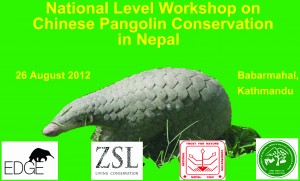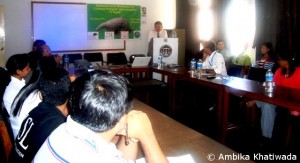 In August 2012, I helped to organize a one day, national level workshop focusing on Chinese pangolin conservation in Nepal. The main objective of the workshop was to share the plan for pangolin conservation work in eastern Nepal (which includes my EDGE Fellowship) and to understand the pangolin research that has been conducted in Nepal to date.
In August 2012, I helped to organize a one day, national level workshop focusing on Chinese pangolin conservation in Nepal. The main objective of the workshop was to share the plan for pangolin conservation work in eastern Nepal (which includes my EDGE Fellowship) and to understand the pangolin research that has been conducted in Nepal to date.
The workshop was chaired by Dr. Maheshwar Dhakal, an ecologist of the Department of National Parks and Wildlife Conservation (DNPWC), and opening remarks were delivered by Mr. Juddha Bahadur Gurung, Member Secretary of the National Trust for Nature Conservation (NTNC). Altogether, there were forty-four participants, representing a wide variety of government authorities, conservation organizations, independent conservation scientists and university students.
Ms. Sarita Jnawali, manager of Kathmandu Central Zoo, presented her experience of pangolins in captivity, highlighting the need for pangolins to be studied in detail in the wild to improve conservation and captive care. Confiscated and rescued pangolins are often brought to the Zoo, but mortality rates are high. My EDGE Fellowship project, and the work of others such as Ms. Namrata Bhandari who is studying pangolins in Shivapuri Nagarjung National Park, will help inform on pangolin ecology.

The wildlife trade control Program Coordinator at WWF Nepal, Mr. Diwakar Chapagain, explained that the illegal trade in species is often highly organized, creating black markets and smuggling syndicates to move and trade the world’s rarest animals and plants. The world’s pangolins were dealt another massive blow in 2011 with possibly as many as 40,000-60,000 individuals slaughtered last year alone. There are two main drivers for this trade: demand in restaurants for wild meat and use in traditional Asian medicine.
The workshop was a very important gathering of conservation scientists and allowed me to present my project to a diverse group of experts and stakeholders. 